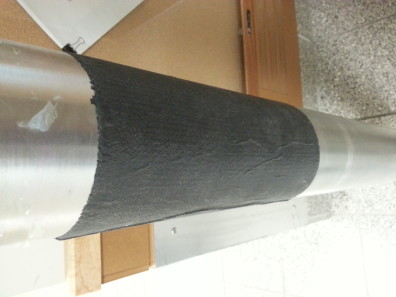Hybrid Propulsion Timeline
kevin.cavenderAs Part of this year’s rocket design effort we have a great and motivated team working to accomplish some lofty goals. Among those are Solid and Hybrid Propulsion Teams which are working on creating and testing our own propulsion system. Our current plan is to implement the solid propulsion this coming year’s competition, while the Hybrid propulsion system is to be vetted for the following year’s rocket. This team has put together this timeline for the year with plans to test early next year. Here is the Timeline: Wish us luck!
Timeline:
Sept. 27-Oct. 3:
- Read up on Hybrid Propulsion from the past teams (3-4 Weeks)
- Prepare and give PowerPoint presentation (Monday)
- Look into Funding (2-3 Weeks)
Oct. 4-10
- Read up on Hybrid Propulsion from the past teams (3-4 Weeks)
- Fuel/Oxidizer Selection (2-3 Weeks)
- Look into Funding (2-3 Weeks)
Oct. 11-17
- Read up on Hybrid Propulsion from the past teams (3-4 Weeks)
- Fuel/Oxidizer Selection (2-3 Weeks)
- Research fuel grain casting methods (2-3 Weeks)
- Look into Funding (2-3 Weeks)
Oct. 18-24
- Read up on Hybrid Propulsion from the past teams (3-4 Weeks)
- Fuel/Oxidizer Selection (2-3 Weeks)
- Research fuel grain casting methods (2-3 Weeks)
- System diagram (3-4 Weeks)
Oct. 19-31
- Research fuel grain casting methods (2-3 Weeks)
- System diagram (3-4 Weeks)
- Assess test stand needs (1-2 Weeks)
- Research necessary gauges for data collection (2-3 Weeks)
Nov. 1-7
- System diagram (3-4 Weeks)
- Assess test stand needs (1-2 Weeks)
- Research necessary gauges for data collection (2-3 Weeks)
- Injector selection (1-2 Weeks)
Nov. 8-14
- System diagram (3-4 Weeks)
- Research necessary gauges for data collection (2-3 Weeks)
- Injector selection (1-2 Weeks)
- Solidworks 3D image of the entire motor and injector (1-2 Weeks)
Nov. 15-21
- Solidworks 3D image of the entire motor and injector (1-2 Weeks)
- Injector creation “scaled” (2-3 Weeks)
- Modify test stand (2-3 Weeks)
- Efficiency calculations (1-2 Weeks)
Nov. 22-28
- Injector creation “scaled” (2-3 Weeks)
- Modify test stand (2-3 Weeks)
- Efficiency calculations (1-2 Weeks)
- EES Modeling of motor (1-2 Weeks)
Nov. 29-Dec. 5
- Injector creation “scaled” (2-3 Weeks)
- Modify test stand (2-3 Weeks)
- EES Modeling of motor (1-2 Weeks)
- Fuel Grain casting “scaled” (1-2 Weeks)
Dec. 6-12
- Fuel Grain casting “scaled” (1-2 Weeks)
- Get approval to test fire “scaled” (1-2 Weeks)
- Test injector water/air “scaled” (1-2 Weeks)
- Data collection (1-2 Weeks)
Dec. 13-19
- Get approval to test fire “scaled” (1-2 Weeks)
- Test injector water/air “scaled” (1-2 Weeks)
- Modifications to prototype “scaled” (1-2 Weeks)
- Data collection (1-2 Weeks)
Jan. 10-16
- Get approval to test oxidizer (1-2 Weeks)
- Analyze Data (1-2 Weeks)
- Modify test stand for oxidizer “scaled” (2-3 Weeks)
- Miscellaneous
Jan. 17-23
- Get approval to test oxidizer (1-2 Weeks)
- Analyze Data (1-2 Weeks)
- Modify test stand for oxidizer “scaled” (2-3 Weeks)
- Miscellaneous
Jan. 24-30
- Modify test stand for oxidizer “scaled” (2-3 Weeks)
- Test fuel/oxidizer “scaled” (2-3 Weeks)
- Make full-scale injector (2-3 Weeks)
- Make full-scale motor casing (2-3 Weeks)
Jan. 31-Feb. 6
- Test fuel/oxidizer “scaled” (2-3 Weeks)
- Make full-scale injector (2-3 Weeks)
- Make full-scale motor casing (2-3 Weeks)
- Analyze Data for fuel/oxidizer test (1-2 Weeks)
Feb. 7-13
- Test fuel/oxidizer “scaled” (2-3 Weeks)
- Make full-scale injector (2-3 Weeks)
- Make full-scale motor casing (2-3 Weeks)
- Analyze Data for fuel/oxidizer test (1-2 Weeks)
Feb. 14-20
- Analyze Data from test (1-2 Weeks)
- Predict expected data for full-scale test (2-3)
- Scale up entire design (3-4 Weeks)
- Modify EES Calculations for full-scale (2-3 Weeks)
Feb. 21-27
- Analyze Data from test (1-2 Weeks)
- Predict expected data for full-scale test (2-3)
- Scale up entire design (3-4 Weeks)
- Modify EES Calculations for full-scale (2-3 Weeks)
Feb. 28- Mar. 5
- Predict expected data for full-scale test (2-3)
- Scale up entire design (3-4 Weeks)
- Modify EES Calculations for full-scale (2-3 Weeks)
- Modify Test Stand for full-scale (2-3 Weeks)
Mar. 6-12
- Scale up entire design (3-4 Weeks)
- Modify Test Stand for full-scale (2-3 Weeks)
- Cast full-scale Motor (3-4 Weeks)
- Get approval for full-scale test (2-3 Weeks)
Mar. 13-19
- Modify Test Stand for full-scale (2-3 Weeks)
- Cast full-scale Motor (3-4 Weeks)
- Get approval for full-scale test (2-3 Weeks)
- Last-minute modifications of full-scale design (2-3 Weeks)
Mar. 20-26
- Cast full-scale Motor (3-4 Weeks)
- Get approval for full-scale test (2-3 Weeks)
- Last-minute modifications of full-scale design (2-3 Weeks)
- Miscellaneous
Mar. 27- Apr. 2
- Cast full-scale Motor (3-4 Weeks)
- Last-minute modifications of full-scale design (2-3 Weeks)
- Full-scale test of prototype (3-4 Weeks)
- Solidworks version of prototype body (2-3 Weeks)
Apr. 3-9
- Full-scale test of prototype (3-4 Weeks)
- Analyze Data from test (2-3 Weeks)
- Solidworks version of prototype body (2-3 Weeks)
- Analyzing of internal piping (2-3 Weeks)
Apr. 10-16
- Full-scale test of prototype (3-4 Weeks)
- Analyze Data from test (2-3 Weeks)
- Solidworks version of prototype body (2-3 Weeks)
- Analyzing of internal piping (2-3 Weeks)
Apr. 17-23
- Full-scale test of prototype (3-4 Weeks)
- Analyze Data from test (2-3 Weeks)
- Analyzing of internal piping (2-3 Weeks)
- Modify prototype for 2nd test (1-2 Weeks)
Apr. 24-30
- 2nd Full-scale test of prototype (2-3 Weeks)
- Modify prototype for 2nd test (1-2 Weeks)
- EES modeling of full-scale rocket (2-3 Weeks)
- Presentation to Rocket group (2-3 Weeks)
May 1-7
- 2nd Full-scale test of prototype (2-3 Weeks)
- EES modeling of full-scale rocket (2-3 Weeks)
- Presentation to Rocket group (2-3 Weeks)
- Modify full-scale rocket (1-2 Weeks)
May 8-14
- 2nd Full-scale test of prototype (2-3 Weeks)
- EES modeling of full-scale rocket (2-3 Weeks)
- Presentation to Rocket group (2-3 Weeks)
- Modify full-scale rocket (1-2 Weeks)
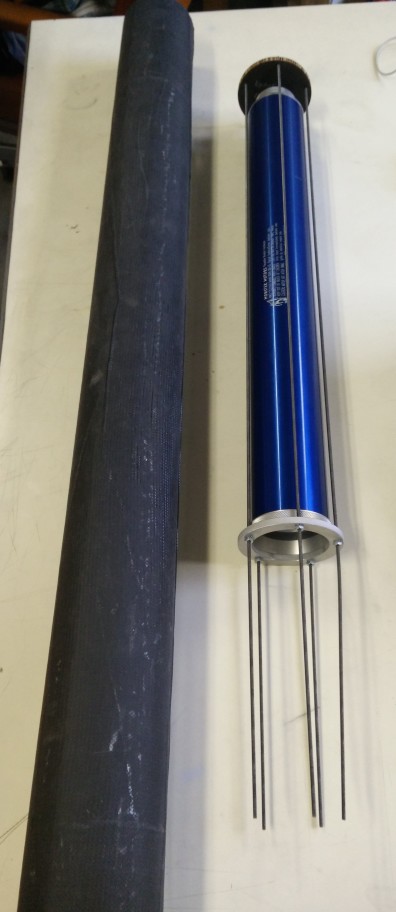
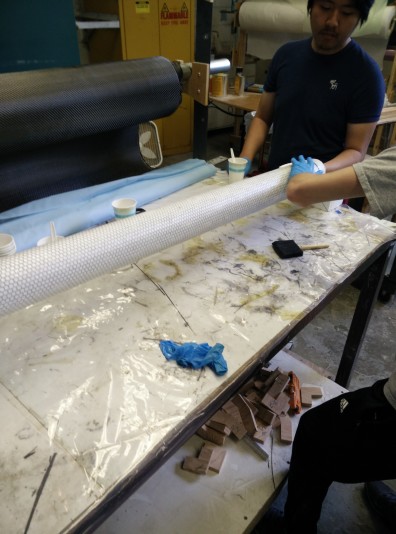

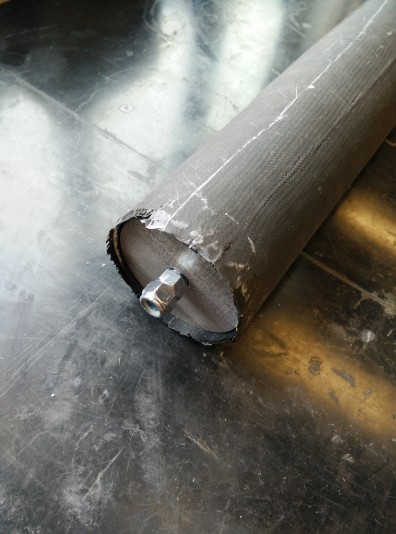

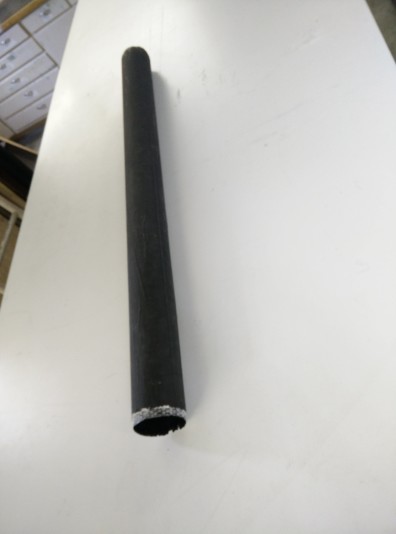

 After Many Tests we have finally moved on to doing the full body section! To keep the body stiff we have decided to add a layer of Aero-Mat as an inner layer. This will add the compression strength we need to ensure there is no buckling during the burn of our motor.
After Many Tests we have finally moved on to doing the full body section! To keep the body stiff we have decided to add a layer of Aero-Mat as an inner layer. This will add the compression strength we need to ensure there is no buckling during the burn of our motor.